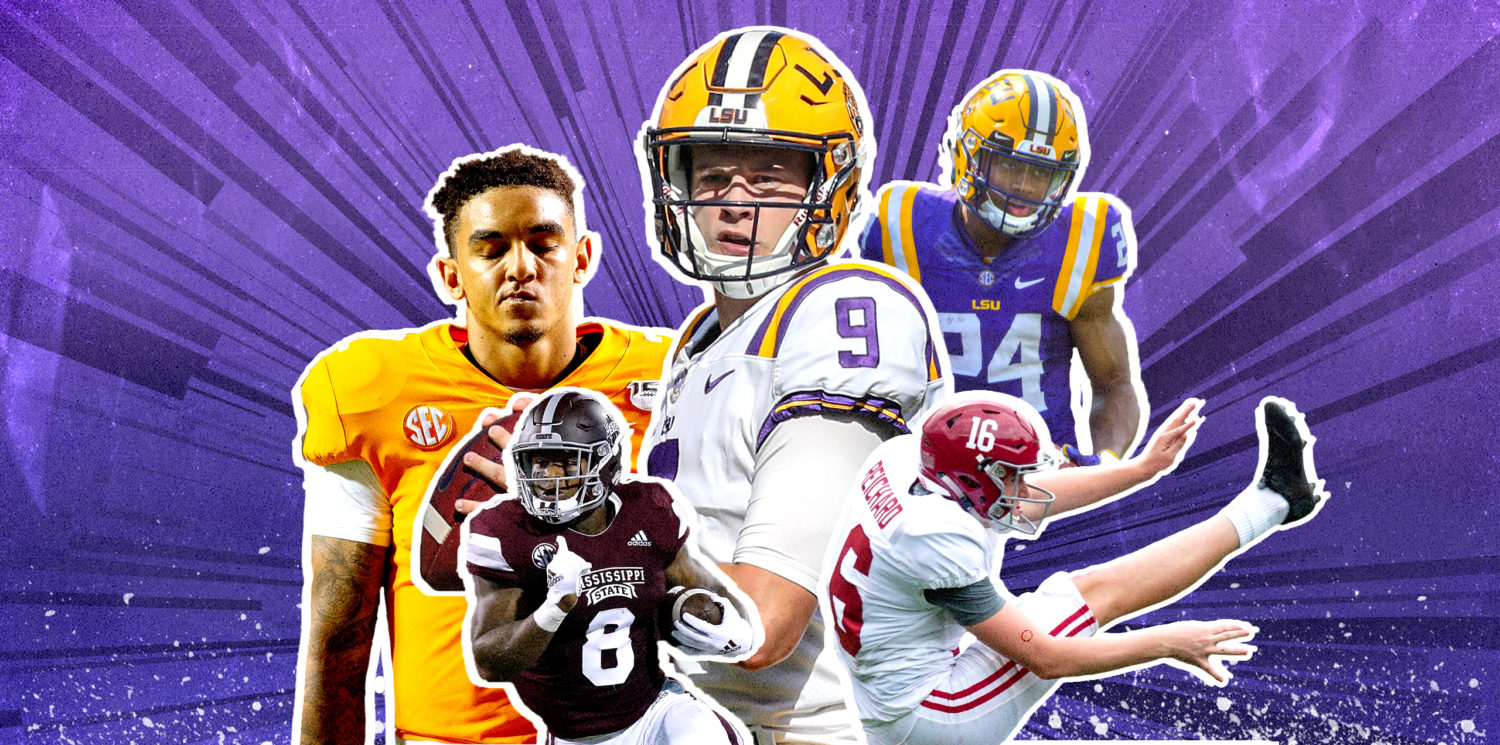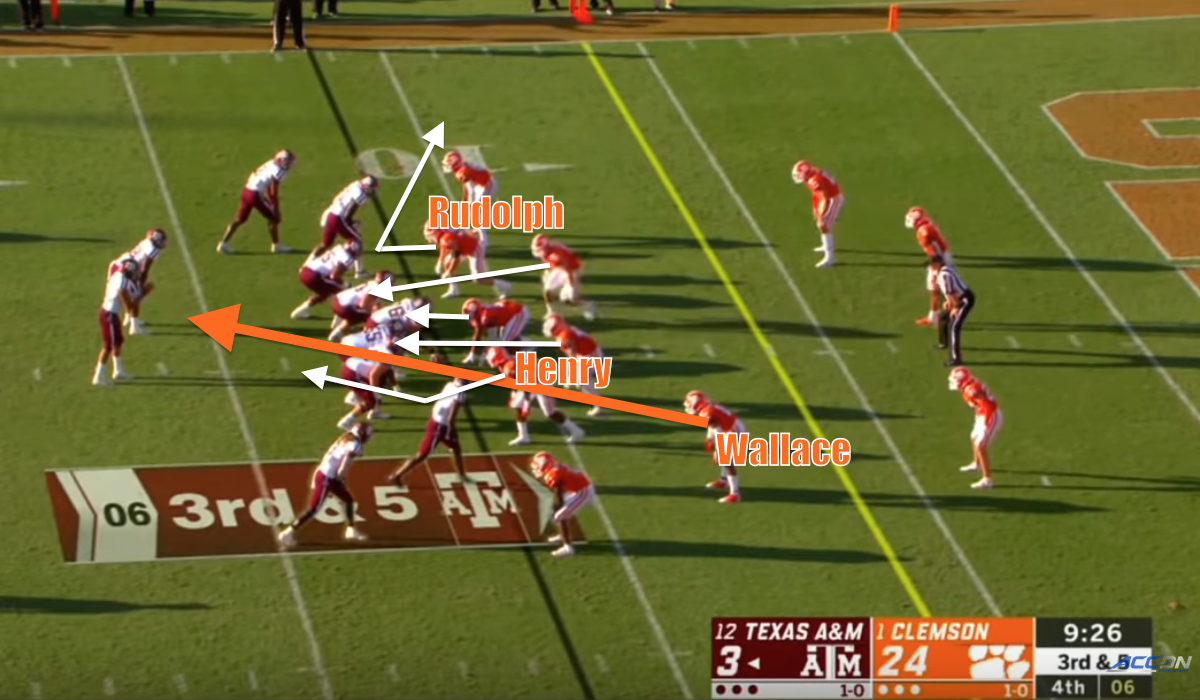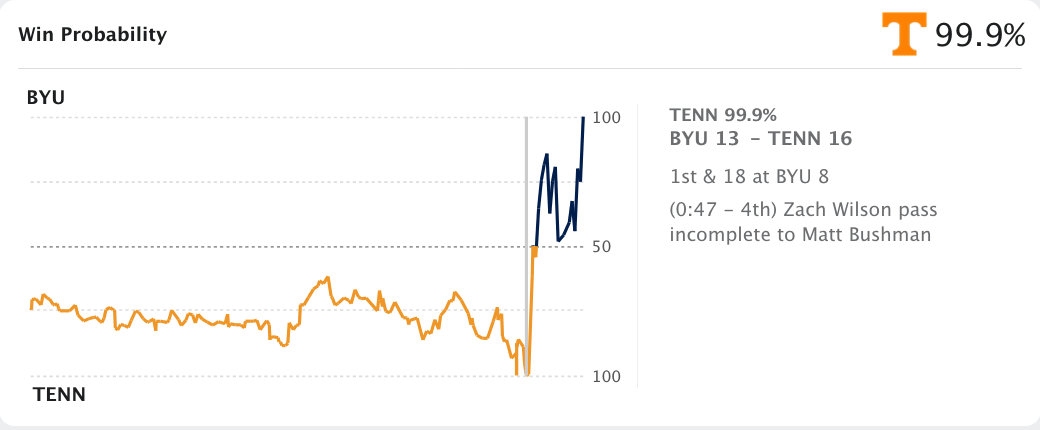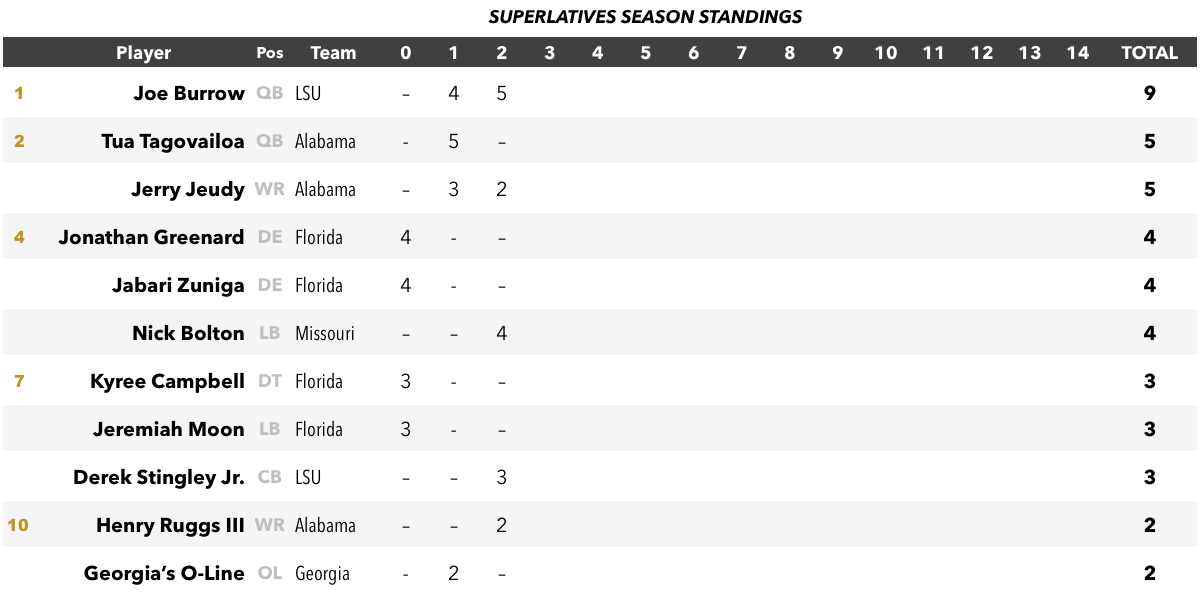
Monday Down South: Yes, LSU has a quarterback. Good luck, world
Is revelatory too strong a word for Joe Burrow’s performance in LSU’s 45-38 win at Texas? I don’t think so. Historic? Not really. Eye-opening? Elevating? Electric? No, no, and no. Try all of the above, along with any other exaltations you want to add to the pile, all the way up to unreal.
Hell, while we’re in the spirit maybe we ought to go ahead and include miraculous, too. Why not? It was that kind of night.
On its own, Burrow’s effort immediately stands as one of the best in LSU history. Despite the hype surrounding the Tigers’ revamped offense – and despite his near-flawless outing in said offense’s debut, an efficient, 55-3 thrashing of Georgia Southern – I was wary of mentioning Burrow in the same breath as the H-word. In my preview of Saturday’s game, I even tried to check my enthusiasm over his white-hot start by emphasizing that, as usual, LSU “probably isn’t going to need a Heisman-worthy performance from its quarterback” to win. Wrong! It very much did, and it got one.
Burrow’s stat line (31-for-39, 471 yards, 4 TDs, 1 INT, 209.7 efficiency) speaks for itself, in any context. Only 1 other LSU quarterback has thrown for more yards in a single game, against any opponent; only 1 other LSU quarterback has posted an efficiency rating of 200 or higher on more than 25 attempts, a distinction Burrow has earned now 2 weeks in a row. Against a top 10 opponent, on the road, in a bona fide shootout, the message was loud and clear: If there was still any doubt, yeah, LSU has a quarterback.
Not just a quarterback: Weapons, too. A whole dang fleet of them, emerging at once. Burrow’s top 3 targets, Justin Jefferson, Ja’Marr Chase and Terrace Marshall Jr., all went over 100 yards, a first for any LSU trio; that added up to 433 yards in all, the 4th-highest receiving total in school history all by itself, on 18.8 yards per catch. (For some comparison, the last great LSU receiving combo, Odell Beckham Jr. and Jarvis Landry, topped out at 275 combined yards vs. an FBS opponent.)
Twenty of their 23 receptions went for first downs or touchdowns. On the ground, Clyde Edwards-Helaire churned out 91 yards on just shy of 6 per carry. As a team, the Tigers averaged more yards per play against Texas (8.4) than any opposing offense in the past 6 years except 1 — Oklahoma, a Playoff-bound team led by the eventual Heisman winner, last October. They also checked in as the nation’s highest-rated offense this week according to ESPN’s Football Power Index.
As with most great performances, though, the numbers alone don’t quite do the thing justice. They don’t reflect the fact that Burrow started slow, committing his only big mistake of the night on a tipped-ball interception inside his own 10-yard line in the first quarter. (The defense bailed him out by forcing a turnover on downs.) From that point on he was almost unstoppable, leading extended scoring drives on 7 of LSU’s next 8 possessions. All 5 of Texas’ scoring drives before its last-ditch effort in the final minute were countered by an immediate response that re-extended the Tigers’ lead.
On the game’s decisive drive, leading 37-31 with 4 minutes remaining in the 4th quarter, coaches doubled down on Burrow’s arm, eschewing the obvious clock-killing strategy by calling 5 passes on the possession’s first 6 plays. On the fifth, he was sacked, setting up a 3rd-and-17 scenario that all but demanded a conservative call to set up a punt. On the sixth, he fully justified their trust and won over the fan base for life:
On 3rd-and-17 in the 4th quarter, Joe Burrow and Justin Jefferson did THIS. pic.twitter.com/uf95gKNdAp
— CBS Sports HQ (@CBSSportsHQ) September 8, 2019
If this season continues to go the way it looks like it’s going to, that’s a potentially legacy-making play. How many LSU quarterbacks in the past 30 years would you trust in that situation to diagnose the pressure, step up the pocket, elude one rusher, and deliver a dead-accurate throw while leaping the air and being planned by another? JaMarcus Russell, maybe. Matt Flynn, eh. Zach Mettenberger or Rohan Davey, on their best day. Now, how many can you imagine actually being allowed to put it to the test? I’m landing on zero.
That leap of faith is where Burrow’s potential is worth jumping the gun on a little “September Heisman” hyperbole. Sure, it’s Week 2. The real season-defining games (read: Alabama) are still ahead. Already, though, the difference between this attack and the meathead mindset that seemed determined to out-Bama Bama by repeatedly hurling Leonard Fournette into the teeth of 8- and 9-man fronts are obvious. Burrow is the key that has allowed OC Steve Ensminger and passing-game coordinator Joe Brady to unlock the Tigers’ explosiveness.
Burrow gives the offense the kind of consistent, composed downfield threat it’s been missing since Mettenberger, at least. The offense gives Burrow both the weapons and, finally, the willingness to exploit them that’s been missing for the past decade. Together – brace yourself, here it comes – they give LSU the best chance it’s had to break the Crimson Tide’s grip on the rivalry and the SEC West at large since the national championship debacle of 2011 established Bama’s supremacy.
Of course, in the context of an 8-year losing streak “the best chance” does not necessarily equal a good chance. FPI rates LSU’s odds of knocking off Bama in Tuscaloosa at just shy of 30 percent, and that’s without taking into account that the Tigers have 2 other top 10 opponents on deck (Florida and Auburn, both in Baton Rouge) in the meantime.
Bill Connelly’s SP+ system gives them only a 25-percent chance of reaching 11 wins, likely the bare-minimum threshold for making a compelling case to be included in the Playoff. And as long overdue as LSU’s offense was for a system upgrade, the spread revolution is old news at Alabama, which has been running on up-to-date schemes for years now. Is the Tigers’ version sustainable against a Playoff-caliber defense, which Texas’ D almost certainly is not? Believe it when you see it.
Still, we saw more than enough on Saturday night to count on Burrow holding up his end of the bargain. That much was encouraging enough. The real revelation was a system that’s designed to give him every opportunity.
Notebook
Around the conference.
LSU 45, Texas 38
The flip side of Burrow’s heroics was a defense that visibly ran out of gas after halftime. The home crowd was impatient with multiple LSU defenders holding up play with apparent leg cramps in the Austin heat, but if it was a deliberate strategy to slow Texas down it failed miserably: UT scored on all 5 second-half possessions, including 4 touchdown drives covering at least 75 yards apiece. Emphasis on drives — unlike LSU, the ‘Horns managed only 2 plays in that stretch that gained more than 20 yards, the biggest coming on a 44-yard, 4th-and-2 touchdown strike from the indefatigable Sam Ehlinger to Devin Duvernay early in the fourth quarter. Everything else came in steady chunks, a surprising percentage of it coming at the expense of the Tigers’ most decorated player.
Devin Duvernay RAN THROUGH Grant Delpit. pic.twitter.com/gpghzQA1QN
— CBS Sports HQ (@CBSSportsHQ) September 8, 2019
With the offenses essentially trading touchdowns over the final three-and-a-half quarters, the difference on the scoreboard ultimately traced back to a pair of 1st-and-goal failures by the Longhorns in the first. On its second series of the game, Texas drove 73 yards in just 5 plays to the LSU 2-yard line, only to come up empty when RB Keaontay Ingram dropped a wide-open touchdown pass from Ehlinger on 4th down. On its next series, LSU turned away the ‘Horns on 4 consecutive snaps inside the 5-yard line (one of which was initially ruled a touchdown before being overturned on review) following Burrow’s lone interception. That turned out to be just about all the defense the offense would need, which was fortunate.
With LSU’s talent on defense, it’s tempting to dismiss the final damage — 38 points on 530 yards of total offense — as par for the course against the best offense the Tigers will face outside of Alabama’s. Ehlinger, Duvernay and Co., are going to inflict worse on a lot of lesser defenses this season; in the end, the Tigers might be one of the few that managed to do enough to survive. But those numbers also represent one of the worst statistical efforts by an LSU defense this decade, and by the end of the night, the notion of generating a stop was all but out the window. If the offense hadn’t held serve, or if Texas had managed to recover the onside kick following its last touchdown, the result might easily have swung the other way.
Then again, the way the schedule shakes out it could be quite a while before Dave Aranda’s unit is properly tested again: The first big conference match doesn’t come until an Oct. 12 visit from Florida, which might as well be required to be a slugfest by SEC bylaws. Ditto subsequent dates with Mississippi State and Auburn. If the defense is vulnerable long-term, it still might take the trip to Tuscaloosa to prove it.
Clemson 24, Texas A&M 10
Texas A&M actually led this game, 3-0, for a brief moment in the beginning the second quarter — so brief you might have forgotten about it entirely by the end of the second quarter — but no one who sat through it can claim that it was ever really in doubt. Based on ESPN’s running win probability graph, the Aggies’ odds of winning peaked at 26.8 percent at the end of the first, after Kellen Mond connected with Camron Buckley for a 20-yard gain on 3rd-and-15 in Clemson territory. It was all downhill from there … especially if you had Clemson covering the spread.
I know Kellen Mond will face some criticism today. He has played better for sure, but I saw him get up from this hit, side of his face all bloodied and keep competing for @AggieFootball I hope fans will appreciate that….I know I do. Not many of us would get up from this. https://t.co/xbqLr9klPh
— Holly Rowe (@sportsiren) September 8, 2019
The evidence of the beating Mond absorbed was all over his face in the aftermath, literally, a much better indicator of just how much heat was under throughout the afternoon than the box score. (The Tigers were credited with a grand total of 2 sacks and 4 QB hurries, all by different players.) Clemson DC Brent Venables easily won the chalkboard battle, consistently crossing up A&M’s protection schemes with 5- and 6-man blitzes out of 2- and 3-down fronts that effectively disguised where the pressure would be coming from.
Almost none of the actual hits the Tigers landed on Mond came from a lineman or linebacker straight-up defeating a blocker in 1-on-1 combat; other than blue-chip DE Xavier Thomas, who was credited with a half-sack in the first half after beating his man off the edge on an obvious passing down, Clemson’s d-line came up surprisingly empty on the stat sheet in terms of sacks, TFLs, or hurries. Instead, it did its job by clamping down against the run (A&M backs Jashaun Corbin and Isaiah Spiller averaged just 2.9 yards on 20 carries) and facilitating a steady diet of unblocked DBs and linebackers in Mond’s face.
A couple times the Tigers were able to generate heat right up the gut; more often it came from the edges. On the same play that Thomas rocketed past the Aggies’ right tackle, he had to share the sack with CB A.J. Terrell, who arrived untouched on a perfectly disguised corner blitz that Mond never saw coming. On the above play that left Mond bloodied, Thomas unexpectedly dropped into coverage on Mond’s right side as three blitzers came screaming in from his left; the result was 5 A&M linemen blocking just 3 Clemson rushers, while unblocked LB Baylon Spector and DB K’Von Wallace raced to chase down Mond from the blindside. (Wallace won.) A bit later on, Clemson clinched the game on a similarly unorthodox blitz, this one involving a single down lineman in the red zone.

On paper, the Aggies are fine here: Even with the lone RB releasing immediately into a pattern, that still leaves 5 blockers for 5 rushers. The problem is that they failed to predict where the pressure would be coming from. To the left of the formation, DE Logan Rudolph peeled off of his pass rush to carry the back into the flat, leaving LT Dan Moore Jr. (No. 65) alone to block air; meanwhile, the all-out rush up the middle successfully occupied the interior line, leaving RT Carson Green (No. 54) to handle both DE K.J. Henry (No. 5 for Clemson) and Wallace, who again disguised his intentions perfectly prior to the snap. Another free run at Mond, a panicked heave, scoring threat averted, game over, drive home safely.
Kellen Mond 17/31 with 1 really bad interception pic.twitter.com/xAbYpowAcn
— Simple Man Radio (@SimpleManRadio) September 7, 2019
That is indeed a really bad interception. But when the alternatives are eating another sack or chucking the ball into the 11th row, and you have to make that decision in the split-second between receiving the snap and suddenly realizing you’re a sitting duck, it’s hardly an inexplicable one. Mond recognized too late that Rudolph attempting to run with RB Isaiah Spiller was a mismatch; he just didn’t have time to set his feet and put the ball where it needed to be.
Mond took his fair share of heat from A&M fans, too, who were hoping to get a glimpse of the quarterback who lit up Clemson last year in College Station and instead saw one who looked as lost as ever in his 23rd career start. Personally, I’m more inclined to chalk up a bad outing against a Brent Venables defense as Brent Venables being really good at this. A lot of perfectly respectable quarterbacks wind up looking lost against Clemson — ask Jarrett Stidham, who endured 11 sacks in Death Valley in a season that ended with his team playing for a Playoff bid in the SEC Championship Game, or, you know, Tua Tagovailoa, who didn’t fare all that much better in last year’s national title game than Mond did Saturday. The list of QBs who have succumbed to Death by Venables is a long and distinguished one.
Anyway, neither Mond nor the Aggies look like they’re going to be playing for any hardware this season, but that was always more of a best-case scenario than a realistic expectation. Everything else is still on the table. The o-line has some work to do before it runs into the likes of Auburn, Alabama, Georgia, and LSU; further judgment withheld until they have a chance to do it.
BYU 29, Tennessee 26 (2OT)
After leaving Neyland Stadium utterly demoralized last week, Tennessee fans showed up surprisingly loud and proud Saturday, buoyed by the assurance that no matter what happened against the Cougars it couldn’t possibly be any worse than losing to a 26-point underdog from the Sun Belt. There’s nowhere to go but up!
Right?
How BYU (+3.5) got into position for the game-tying field goal ?: https://t.co/EZfPHGjctV
— Action Network (@ActionNetworkHQ) September 8, 2019
Oh. Oh no.

Truly that is the trajectory of despair. Not only did the Vols lead virtually throughout regulation: In the seconds just before Zach Wilson’s 64-yard heave to Micah Simon to set up the game-tying field goal, their odds of blowing it were so low they barely registered on the graph. Statistically, that means that if you simulated the final minute of the game 1,000 times from the moment BYU took possession at its 16-yard line, 999 of those simulations would result in a Tennessee win. The one that doesn’t? That’s the reality.
It’s slightly incredible that the Cougars still had even a theoretical fraction of a chance. Tennessee squandered opportunity after opportunity: After driving for a touchdown on their opening possession, the Vols managed just 9 points in regulation on 5 more trips inside the BYU 35-yard line, settling for 3 field goals and twice getting stopped on downs. BYU, on the other hand, scored its only regulation TD on a short field courtesy of a killer interception off Jarrett Guarantano. Otherwise, the Cougars were severely outgained in total offense and never seriously threatened to put the ball in the end zone until overtime. The collapse was not inevitable, but the fact that Tennessee outplayed them for 59-plus minutes made it that much worse.
Whatever the circumstances, the implications of an 0-2 start in supposedly 2 of the most winnable games on the schedule are dire. The Vols should get in the win column this weekend against Chattanooga, and heaven help Jeremy Pruitt if they don’t; beyond that, they’ll plunge into the deep end of the SEC slate, a stretch that could realistically eliminate them from bowl contention by Halloween. By November, the main question is likely to be whether they can avoid finishing in the SEC East basement for the third year in a row and whether it’s too soon — or too expensive — to pull the plug on the Pruitt administration if they do.
At this point, it’s pretty much a given that it’s going to get worse before it gets better. Whether Pruitt’s around for the latter may depend on just how much worse, and for how long.
Alabama 62, New Mexico State 10
I don’t want to suggest that Alabama’s perpetually looming kicking issues are solved. Far from it, when one ill-time miss always has the potential to derail the season. But true freshman Will Reichard’s afternoon against the Aggies was encouraging: After clanging both of his field-goal attempts in the season opener off the uprights, Reichard was 2-for-2 on Saturday from 48 and 49 yards, respectively, burying both tries with room to spare. The latter matched Bama’s longest successful field goal in 2018 on 20 attempts.
Reichard was also 8-for-8 on PATs and drove 9 of his 10 kickoffs for touchbacks, for good measure. Distance is not going to be a concern. Consistency: TBD. But something drastic is going to have to happen to supplant him as the resident foot.
Superlatives
The best of the week.
1. LSU QB Joe Burrow
Burrow looked like a future 1st-rounder in Austin, and might not be the only one on LSU’s offense. His 9 touchdown passes over the first 2 weeks of the season are tied for the national lead.
2. Missouri LB Nick Bolton
Watch: Nick Bolton had a huge day for #Mizzou.
He ended the day with two tackles for loss and two interceptions, one of which turned into a pick six. pic.twitter.com/aPLaYniwCa
— Nathalie Jones (@NathalieJonesTV) September 7, 2019
Bolton, a true sophomore, headlined a dominant defensive effort for Mizzou in a 38-7 rout over West Virginia, racking up a team-high 10 tackles (including 3 of the Tigers’ 15 tackles for loss) and 2 interceptions, the second of which he took back for a touchdown to cap the scoring in the fourth quarter. Altogether, the Mountaineers managed a miserable 171 yards of total offense on 2.9 per play and didn’t get on the board until garbage time.
3. LSU CB Derek Stingley Jr.
#LSU CB #24 Derek Stingley Jr. locates the football better than most freshmen locate their classes. pic.twitter.com/uWGDs4ZrhT
— Fed Scivittaro (@MeshPointScout) September 8, 2019
Stingley, a true freshman, was the brightest spot in a surprisingly vulnerable LSU secondary, living up to his 5-star recruiting hype and then some opposite Texas’ dynamic, 6–6 jump-ball specialist, Collin Johnson. Although Johnson caught 3 passes for 48 yards, none of them came in the vicinity of the 6-1 Stingley — the freshman won both of his 1-on-1 downfield battles with the bigger target and nearly came away with his first career interception to show for it. Getting to replace Greedy Williams with this kid is almost unfair.
4. Alabama WRs Jerry Jeudy and Henry Ruggs III
Picking just one Bama receiver for this distinction every week might prove as difficult as covering them. Ruggs, a hyper-efficient one-man touchdown machine as always, opened the scoring bonanza against New Mexico State with a 75-yard TD run on the first play from scrimmage — yes, it went in the books as a run, not a catch — and added a second score on a 39-yard reception. Jeudy, showing no mercy on the hopelessly overmatched NMSU secondary, accounted for 103 yards and 3 scores on 8 receptions, his second consecutive game over the century mark.
5. Mississippi State RB Kylin Hill
Kylin Hill is a cheat code. Simple as that.
(Via @SECNetwork)pic.twitter.com/opPNEK6fBA
— PFF College (@PFF_College) September 7, 2019
Hill made the most of his 16 touches in the Bulldogs’ 38-15 win over Southern Miss, racking up 141 total yards and frequently posterizing the Eagles in the process — breaking tackles, hurdling dudes, at one point nearly running clean out of his jersey as a USM defender hung on for dear life. Through 2 weeks he ranks second nationally in rushing yards (320) and 3rd in yards from scrimmage (349).
Honorable Mention: Auburn DE Marlon Davidson, who supplied steady diet of pressure in Auburn’s 24-6 win over Tulane, finishing with 6 tackles, 2 TFLs, and a QB hurry. … Ole Miss WR Elijah Moore, who went a long way toward establishing himself as the Rebels’ new go-to target with 7 catches for 130 yards and 2 TDs in a 31-17 win over Arkansas. … Mississippi State DB Brian Cole II, who was everywhere in the Bulldogs’ win over Southern Miss with 7 tackles, 3 TFLs, and a sack. … Tennessee RB Ty Chandler, who went for 154 yards against BYU on 5.9 per carry. … South Carolina QB Ryan Hilinski, who finished 24-of-30 for 282 yards and 2 TDs in his first career start, a 72-10 thrashing of Charleston Southern. … And South Carolina’s offensive line, which paved the way for 493 yards rushing and didn’t allow a sack. Next up: Alabama!

